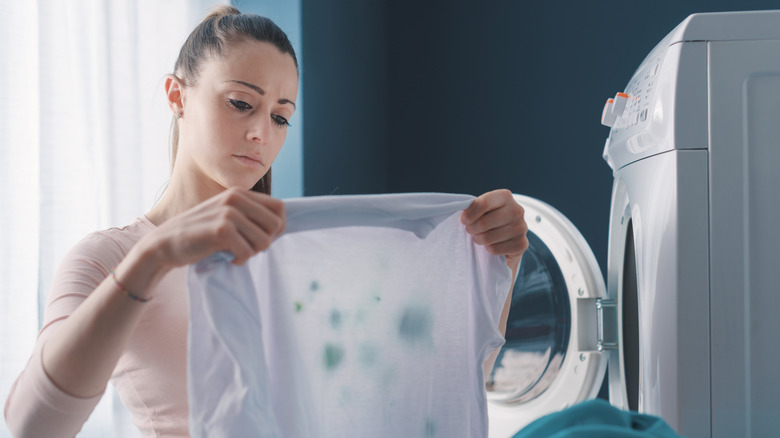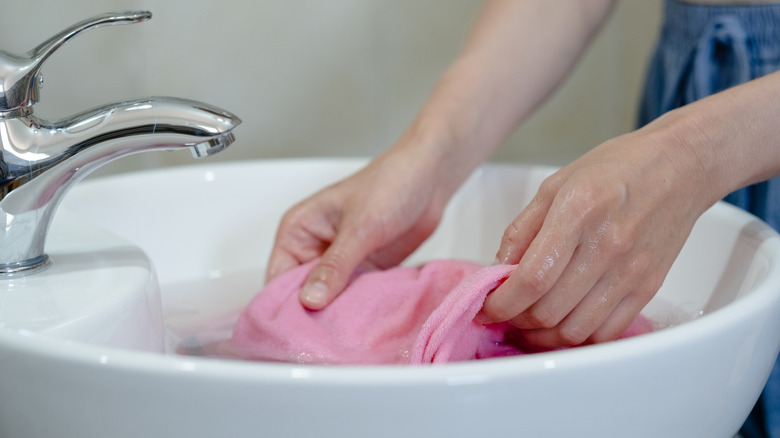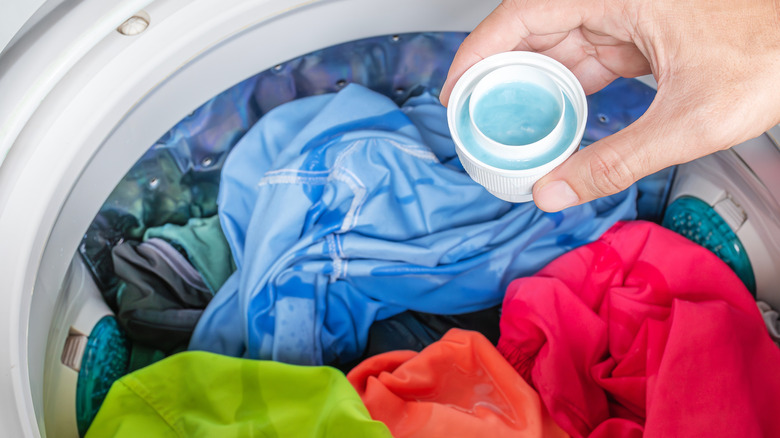The Vinegar Hack To Quickly Remove Detergent Stains Out Of Laundry
We rely on our laundry detergent to clean our clothes and get rid of the icky odors they pick up throughout the day, but sometimes, the very thing that's supposed to help can actually do more harm than good. If you've ever pulled your clothes out of a fresh load of laundry and noticed blue spots, greasy stains, white marks, rough patches, or even a waxy residue, your detergent might be the culprit. Luckily, a vinegar soak can actually help remove detergent stains from your laundry. Yes, really!
Thanks to its acidic nature (specifically the active component, acetic acid), vinegar has the power to cut through stubborn stains left behind by laundry detergent. It can also help with other types of clothing stains, eliminate odors, and even soften your clothes. Believe it or not, vinegar is a versatile cleaning tool worth keeping on hand, and it works wonders in the laundry room.
Remove laundry detergent stains with vinegar
To eliminate laundry detergent stains from clothing using vinegar, you'll want to start by presoaking the garment in a white vinegar and water mixture. Fill your sink or a large bowl with warm water, then add 1 cup of white vinegar. Let the garment soak for up to an hour, and use your fingers to gently rub the stain every 15 minutes or so. After soaking, lightly squeeze out the excess water and vinegar, then run the garment through the washing machine without adding any detergent.
While this method can be effective at getting rid of the toughest laundry stains, it might take more than one attempt, so patience is key here. Additionally, vinegar can also be used as a laundry additive every other week to help eliminate other types of stains, remove lingering odors, and even soften your clothes. Add 1/2 cup of diluted white vinegar to a full load of laundry. You can either pour it in just before the final rinse cycle or add it to the fabric softener compartment at the start of the wash.
Keep in mind, though, that vinegar doesn't pair well with bleach (it's actually toxic!). So before using it, check your detergent label to make sure it doesn't contain bleach or chlorine-based ingredients. Also note that that vinegar should be used with extra care on more delicate garments, like clothing that contains elastic. Because it can wear down those materials over time, ensure it is properly diluted before using.
Common causes of laundry detergent stains
Knowing how to remove laundry detergent stains with an eco-friendly kitchen staple can help preserve your clothing and save you from tossing a favorite garment. But preventing those stains in the first place can spare you the hassle of giving individual pieces extra attention. Laundry detergent stains can happen for a few different reasons. The first is overloading your washer. When you cram too many clothes into the machine, it interferes with the soap's ability to disperse properly. Instead of swirling evenly through the load, the clothes just get swished around, and the detergent ends up clinging to certain spots on your garments. Luckily, there are simple laundry tips to prevent overloading your washer.
Another culprit is loading the detergent incorrectly. This can happen if you use powder detergent with cold water (cold water can cause the powder to clump and stick in one spot, like how flour does when it gets wet), put the wrong type of detergent in the dispenser, or simply use too much detergent, preventing it from fully dissolving. Hard water can also be a factor. If your water has a high mineral content, often spotted by the buildup around your fixtures, stick to liquid detergent over powdered forms as it may reduce the chances of detergent stains forming.


